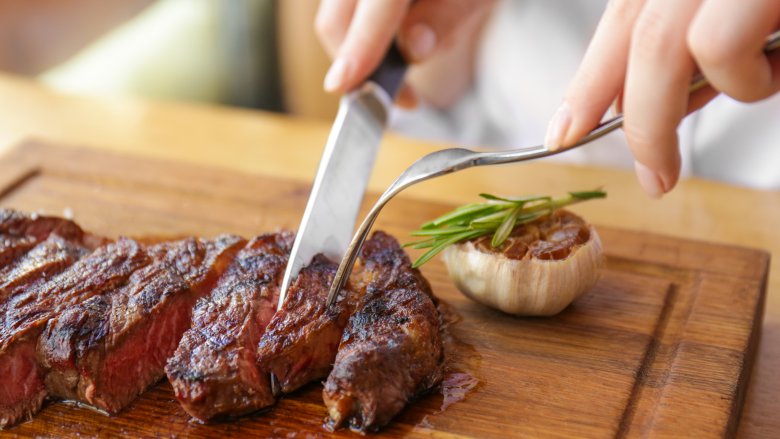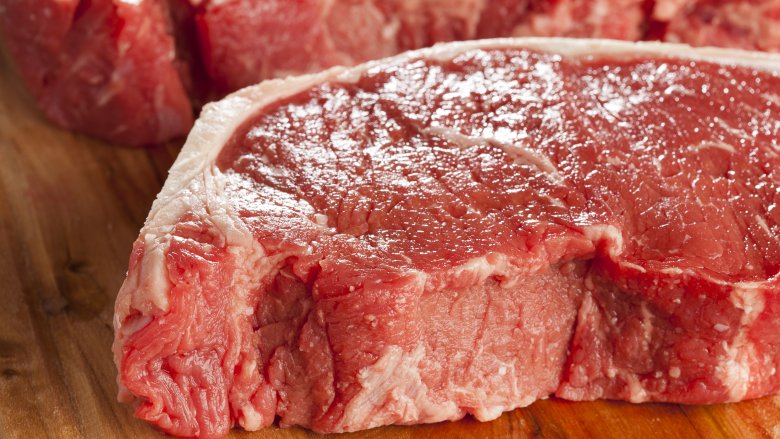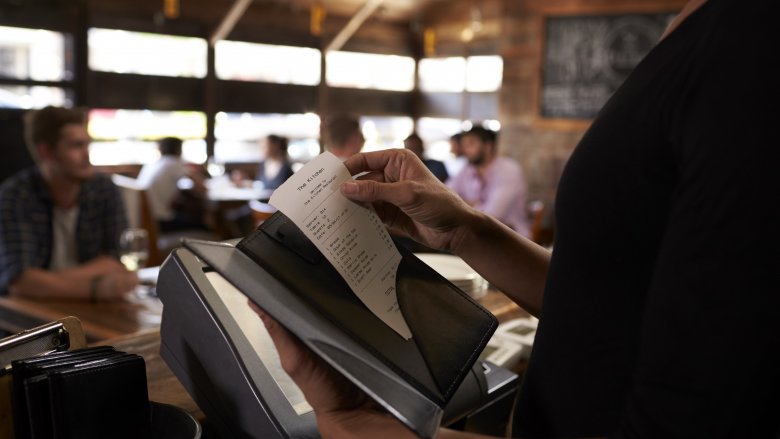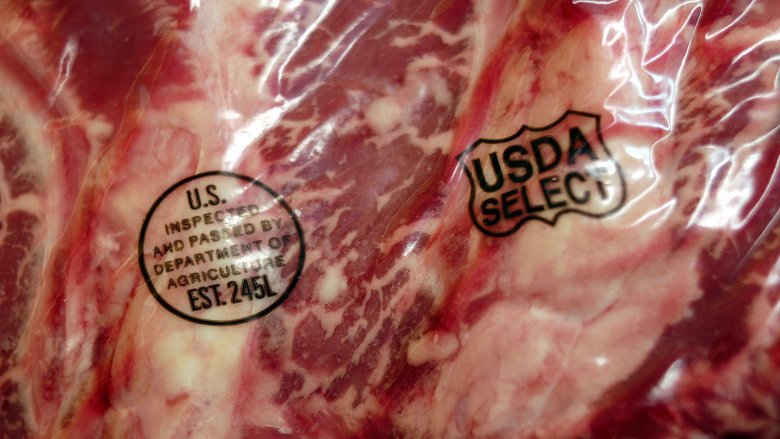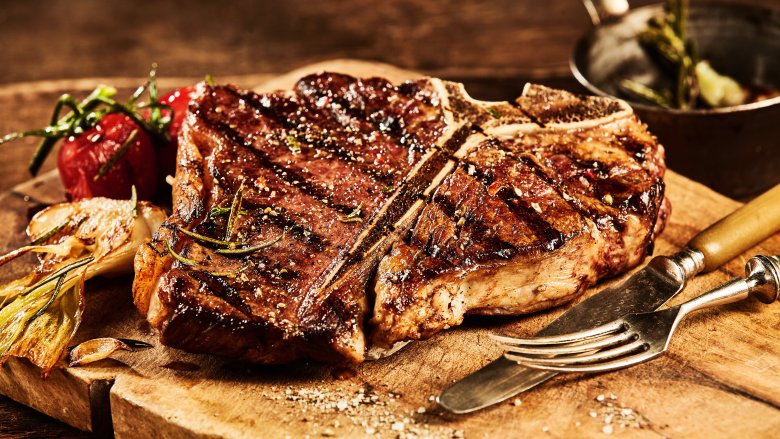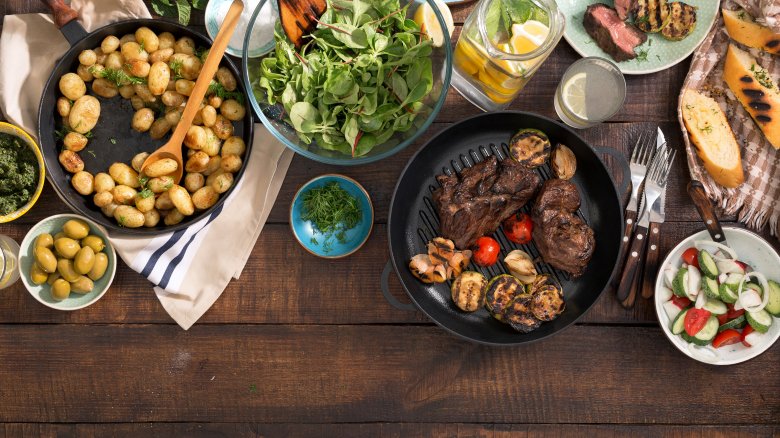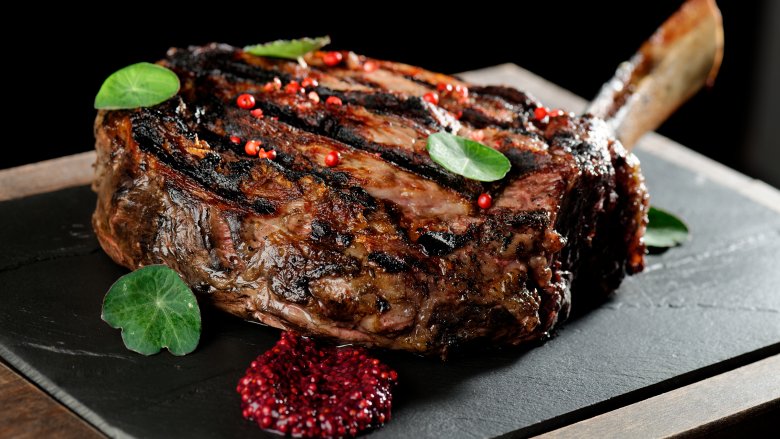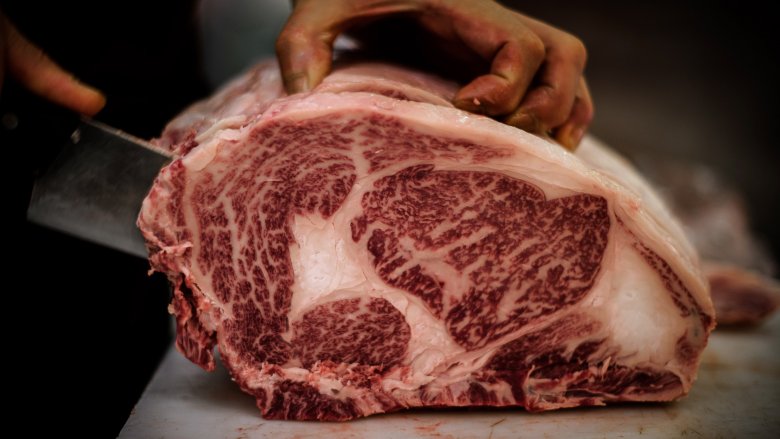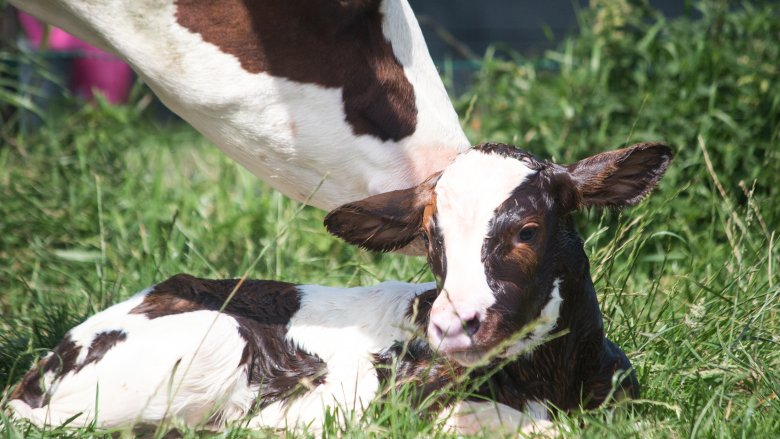The Real Reason Steakhouses Are Disappearing
There was a time that anyone wanting a special meal would head to a steakhouse. Anniversaries, promotions, birthdays — they were all celebrated in true American fashion: over a giant slab of meat. But the 21st century hasn't been kind to the steakhouse, and across the country, they're disappearing.
As far back as 2008, steakhouse staples Ponderosa and Bonanza were fighting failure, and according to USA Today, they closed 305 locations (or 63.5 percent of their footprint) in the wake of bankruptcy. Small chains have fared no better, and Delaware Business Now reported that Bugaboo Creek shuttered all their locations in 2016. The same year, Logan's Roadhouse filed for bankruptcy and started fixing problems by closing 18 locations (via Tennessean), and from 2016 into 2017, Lone Star Steakhouses started closing across nine states, according to Restaurant Business.
The most high-profile series of closures and struggles comes from Outback Steakhouse (who we took an in-depth look at here). In 2017, they announced (via Business Insider) they would close dozens of restaurants, and all those closures are signs of a bigger problem.
Rising beef prices
Steakhouses have been hard hit when it comes to the cost of doing business, as beef prices have been steadily rising.
As early as 2013, Beef Magazine was reporting on prices that were rising because of drought conditions. Instead of getting better, market prices have continued to rise. Financial Times reported that meat prices rose globally in 2017, increasing 9 percent. And when Food Business News compared beef prices on March 9, 2018 to March 9, 2017, they found a 2 percent increase. They say the increasing prices are being driven by increased demand, as US beef exports also hit record highs. Production is struggling to keep up, but it's not enough.
And that's hurting steakhouses. Even back in 2012,when Business Insider reported on the closing of Wall Street favorite Ben Benson's Steak House, they cited rising costs of beef as one of the major factors in shuttering the restaurant. Fast forward to 2017, when the New York Post talked to steakhouse owners across the country. Some places — like Pat LaFrieda Meat Purveyors — saw their beef prices jump about 20 percent, and that's not the kind of cost increase anyone is happy about.
Consumers think they're too pricey
Those rising beef prices sometimes mean rising menu prices, and customers aren't having it. Browse online reviews of some of the country's biggest steakhouses and you'll start to notice a trend. Many, many people think they're just too expensive, a criticism that's resulted in low ratings for places like LongHorn Steakhouse and Fleming's Prime Steakhouse.
According to Reuters, rising beef prices have started a sort of domino effect seen throughout the nation's steakhouses. By 2011, budget-conscious Americans were continuing a decade-long trend of favoring cheaper cuts of meat. Fewer people were going out and buying rib eyes and tenderloins at high-end steak places, and with restaurant prices remaining high, they were opting to get their steak fix in a more affordable way — like cooking it at home.
And heading out to a high-end steak place isn't cheap, especially if you're looking for a legitimately delicious steak that's way better than you can cook at home. Quality comes at a price, and in 2016 The Daily Meal looked at some of the most expensive steakhouses in the country. What kind of prices are we talking? Diners could expect to spend $90 to $120 each, and there aren't too many families that can afford to do that on a regular basis.
A lot of steak isn't great
They say that you get what you pay for, and that's definitely true of steaks. While high-end steakhouses might be scaring away customers with their high price tags, steakhouses that have historically been more accessible are finding they have another problem: people now know they're getting steaks that are no better than what they can pick up at their favorite grocery store or local butcher.
According to James Beard Award-winning food writer Josh Ozersky (via Time), one of the biggest problems with America's steakhouses is the quality of the steaks they serve. Most, he says, aren't serving USDA Prime, they're cooking lower grades of steak. They often use tenderizing methods like poking the meat with needles, adding MSG, and using butter to mask the toughness and the texture. So unless you're prepared to spend big bucks at a big-city steakhouse, more and more people are just opting to make their own.
We're no longer so quick to indulge
You are what you eat, the old saying goes, and there's something to that. While your blueberry flavored gum might not make you turn into a literal blueberry, the dining choices you make says a lot about who you are. And that, says James Beard Award-winning food writer Josh Ozersky (via Time), is at the heart of one of the big problems Americans are having with steakhouses.
He describes them as, "... closer in spirit to strip clubs or spas, places to which people repair for rites of costly self-indulgence. ... Both the steakhouse and the strip club seem to offer the most primal of pleasures, but the actual exchange is cynical, unsatisfying, and almost prohibitively expensive."
Ozersky argues that at one time, heading to a steakhouse to gorge yourself on a massive piece of meat was up there at the top of the pyramid of life's pleasures. There are slabs of steak, too much alcohol, desserts so indulgent they'll make you sick... and modern Americans just aren't into that any more. At a time when restaurants are going increasingly healthy, steakhouses are a relic of a not-so-distant past.
Millennials are going elsewhere
It's easy to underestimate just how much change each new generation brings with it, and in 2017, Forbes said we were at a tipping point. Millennials were on the edge of having more spending power than any other generation, and with an estimated $200 billion worth of cash behind them, their preferences are a big deal.
That's definitely visible in how they eat, and according to Business Insider, the spending habits and preferences of the millennial generation is forcing an overhaul of the restaurant industry. Going out to eat used to be a big deal, as much about being social as it was about the food. Casual dining and steakhouses were supreme, places where people could sit down and expect to spend a few hours chatting over their meal.
But millennials are gravitating more toward speed and convenience, preferring fast-casual chains like Chipotle, pick-up and delivery options, and meal delivery kits to their parents' favorite steakhouses. Food service industry analyst Bonnie Riggs says the only sector of casual dining that's growing is off-premise options, and for steakhouses, that's a huge problem. Sorry, millennials just don't have time for you.
They're carefully disguised
Restaurants need to change to meet the demands of a changing market, and places that have been traditional steakhouses are rebranding themselves in order to attract new customers — including millennials. That means there are fewer places with menus that are little more than a slab of meat and traditional sides, and if you were to show your parents and grandparents a 21st century steakhouse, they might not even recognize it.
Take Quality Eats, a restaurant Observer called the "Only Steakhouse Catering to Millennials." It's not just steak on the menu, it's creative, millennial-friendly dishes like bacon served with peanut butter, jalapenos, and apples, with plenty of colorful cocktails. Maple & Ash had a similar idea, says Huffington Post, padding out their traditional steakhouse menu with seafood options and crazy desserts.
When Munchies talked to steakhouse owners Gregory and Gabrielle Quinonez Denton, they made it clear that old-school steakhouses were a thing of the past. They made sure their Portland, Oregon steakhouse, Ox, has staying power by adding a ton of vegetarian and vegan options. Meat-centric restaurants catering only to carnivores are finding a limited market now, so they need to appeal to everyone.
Red meat has a bad rap
Red meat has been one of the foods continuously condemned for saturated fat, cholesterol, and something called L-carnitine, all of which is linked to heart disease (via Harvard Health). Those developments haven't helped the image of the steakhouse.
Let's start with what the American Heart Association says is a healthy amount of red meat. They recommend limiting yourself to around 5 ounces a day, which is essentially a piece of meat about the size of a deck of cards. And that's a huge amount less than that 24-ounce steak you order every time you go to a steakhouse, isn't it?
Men's Health looked at how hard it can be to eat healthy at a steakhouse, and it's a challenge. Not only is the huge amount of red meat a problem, but there's a good chance the starters and sides are all high-fat, high-calorie, and deep-fried. All those potatoes can be a major pitfall, fattier cuts of meat make your meal even worse, and do you really know what's in that sauce? It's no wonder health-conscious diners might give steakhouses a miss.
Kobe beef left a bad taste
People want to be able to trust a restaurant, and when the truth about Kobe beef started to come out, it didn't make steakhouses look good.
Forbes' Larry Olmsted called the industry's promotion of Kobe beef "Food's Biggest Scam." At the time he was writing — 2012 — there were a ton of US steakhouses that advertised Kobe beef on their menu. They also charged exorbitant prices for it, but there was a catch: no real, authentic, Japanese Kobe beef was sold anywhere in the US.
In the following years, Olmsted revisited the issue and the changes the industry saw. By 2014, there were nine restaurants in the US authorized to sell real Kobe beef, and that's still not a heck of a lot of places. It was super-rare even in Japan, Olmsted says, and he also says that most of the time, a steakhouse that advertises Kobe beef is outright lying. When Inside Edition ran their expose in 2016, they found there were even some Michelin-starred steakhouses supposedly offering Kobe beef... and lying about it. That doesn't inspire a lot of confidence, does it?
There's more concern with animal welfare
We're not just getting more aware of how healthy our food is, we're also becoming more aware of where it comes from. When you start talking about meat, it's a tricky subject even for people who aren't vegetarian or vegan. When Prevention wrote a piece on the cruelest foods on the market, it included things like veal, foie gras, balut... and beef.
Yes, beef. We won't get into the gory details, but some think factory farms and slaughterhouses are so bad it's worth putting everything on the line to stop them. Protesters have descended on steakhouses from Toronto to Australia, not just condemning the restaurant but the diners eating there.
In 2016, a coalition of 50 organizations set their sights on Darden Restaurants, the parent company of places like Olive Garden and Longhorn Steakhouse. The Center for Biological Diversity says the movement was focused on getting the chain to do more to improve their animal welfare standards, and only source meat from responsible organizations. Even though Darden talked the talk, they didn't walk the walk, organizers said, and that's not good publicity surrounding an already uncomfortable subject.
